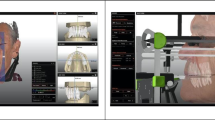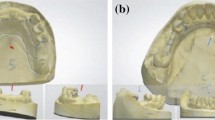Abstract
Objectives
The aim of this study was to comparatively assess the surface roughness parameters, the hardness, and the elemental and molecular alterations induced on CPTi surfaces after conventional finishing and finishing with electro discharge machining (EDM).
Materials and methods
A completed cast model of an arch that received four implants was used for the preparation of two grade II CPTi castings. One framework was conventionally finished (CF), whereas the other was subjected to EDM finishing. The surface morphology was imaged employing SEM. 3D surface parameters (S a, S q, S z, S ds, S dr, and S ci) were calculated by optical profilometry. The elemental composition of the treated surfaces was determined by energy dispersive X-ray analysis, whereas the elemental and chemical states of the outmost layer were investigated by X-ray photoelectron spectrometry. Surface hardness was also tested with a Knoop indenter. The results of surface roughness parameters, elemental analysis, and hardness were compared using unpaired t test (a = 0.05).
Results
The EDM group demonstrated a rougher surface, with a significant uptake of C and Cu. The CF surface mainly consisted of TiO2. On EDM surface though, Ti was probed in different chemicals states (TiO2, Ti2O3, TiC and metallic Ti) and Cu was traced as Cu2O and CuO. Hardness after EDM was almost ten times higher than CF.
Conclusions
EDM significantly affected surface roughness, chemical state, and hardness properties of grade II CPTi castings in comparison with CF.
Clinical relevance
The morphological and elemental alterations of EDM-treated CPTi surfaces may strongly contribute to the reduced corrosion resistance documented for this procedure. The degradation of electrochemical properties may have further biological implications through ionic release in the oral environment.






Similar content being viewed by others
References
Skalak R (1983) Biomechanical considerations in osseointegrated prostheses. J Prosthet Dent 49:843–848
Sones AD (1989) Complications with osseointegrated implants. J Prosthet Dent 62:581–585
Zarb GA, Symington JM (1983) Osseointegrated dental implants: preliminary report on a replication study. J Prosthet Dent 50:271–276
Andersson M, Bergman B, Bessing C, Ericson G, Lundquist P, Nilson H (1989) Clinical results with titanium crowns fabricated with machine duplication and spark erosion. Acta Odontol Scand 47:279–286
Rubeling G (1999) New techniques in spark erosion: the solution to an accurately fitting screw-retained implant restoration. Quintessence Int 30:38–48
Renner AM (2000) Fabrication of implant overdentures that are passive and biocompatible. Implant Dent 9:96–101
Van Roekel NB (1992) Electrical discharge machining in dentistry. Int J Prosthodont 5:114–121
Ercoli C, Graser GN, Tallents RH, Hagan ME (1998) Alternative procedure for making a metal suprastructure in a milled bar implant-supported overdenture. J Prosthet Dent 80:253–258
Weber H, Frank G (1993) Spark erosion procedure: a method for extensive combined fixed and removable prosthodontic care. J Prosthet Dent 69:222–227
Abduo J, Lyons K, Bennani V, Waddell N, Swain M (2011) Fit of screw-retained fixed implant frameworks fabricated by different methods: a systematic review. Int J Prosthodont 24:207–220
Contreras EF, Henriques GE, Giolo SR, Nobilo MA (2002) Fit of cast commercially pure titanium and Ti-6Al-4V alloy crowns before and after marginal refinement by electrical discharge machining. J Prosthet Dent 88:467–472
Eisenmann E, Mokabberi A, Walter MH, Freesmeyer WB (2004) Improving the fit of implant-supported superstructures using the spark erosion technique. Int J Oral Maxillofac Implants 19:810–818
Romero GG, Engelmeier R, Powers JM, Canterbury AA (2000) Accuracy of three corrective techniques for implant bar fabrication. J Prosthet Dent 84:602–607
Sartori IA, Ribeiro RF, Francischone CE, de Mattos MG (2004) In vitro comparative analysis of the fit of gold alloy or commercially pure titanium implant-supported prostheses before and after electroerosion. J Prosthet Dent 92:132–138
Linehan AD, Windeler AS (1994) Passive fit of implant-retained prosthetic superstructures improved by electric discharge machining. J Prosthodont 3:88–95
Nakaoka MM, Nunez-Pantoja JM, Takahashi JM, Consani RL, Mesquita MF (2011) Misfit of pure titanium frameworks: effect of veneer coverage and spark erosion process. Acta Odontol Scand 69:238–242
Zinelis S (2007) Surface and elemental alterations of dental alloys induced by electro discharge machining (EDM). Dent Mater 23:601–607
Ntasi A, Mueller WD, Eliades G, Zinelis S (2010) The effect of electro discharge machining (EDM) on the corrosion resistance of dental alloys. Dent Mater 26:e237–245
Gadelmawla E, Koura M, Maksoud T, Elewa I, Soliman H (2002) Roughness parameter. J Mater Process Technol 123:133–145
NIST X-ray Photoelectron Spectroscopy Database (2007) NIST. http://srdata.nist.gov/xps/. Accessed 25 Dec 2010
Armitage DA, Grant DM (2003) Characterisation of surface-modified nickel titanium alloys. Mat Sci Eng A Struct 349:89–97
Galuska AA, Uht JC, Marquez N (1988) Reactive and nonreactive ion mixing of Ti films on carbon substrates. J Vac Sci Technol A 6:110–122
Ermolieff A, Bernard P, Marthon S, Wittmer P (1988) Nitridation of polycrystalline titanium as studied by insitu angle-resolved X-ray photoelectron-spectroscopy. Surf Interfac Anal 11:563–568
CasaXPS (2011) XPS spectra. www.casaxps.com. Accessed 12 Aug 2012.
Fuggle JC, Kallne E, Watson LM, Fabian DJ (1977) Electronic-structure of aluminum and aluminum-noble-metal alloys studied by soft-X-ray and X-ray photoelectron spectroscopies. Phys Rev B 16:750–761
Capece FM, Dicastro V, Furlani C, Mattogno G, Fragale C, Gargano M, Rossi M (1982) Copper chromite catalysts—XPS structure elucidation and correlation with catalytic activity. J Electron Spectrosc 27:119–128
Chen SL, Yan BH, Huang FY (1999) Influence of kerosene and distilled water as dielectrics on the electric discharge machining characteristics of Ti-6Al-4V. J Mater Process Technol 87:107–111
Simao J, Lee HG, Aspinwall DK, Dewes RC, Aspinwall EM (2003) Workpiece surface modification using electrical discharge machining. Int J Mach Tool Manuf 43:121–128
Theisen W, Schuermann A (2004) Electro discharge machining of nickel–titanium shape memory alloys. Mat Sci Eng A Struct 378:200–204
Wang ZL, Fang Y, Wu PN, Zhao WS, Cheng K (2002) Surface modification process by electrical discharge machining with a Ti powder green compact electrode. J Mater Process Technol 129:139–142
Papadopoulos T, Zinelis S, Vardavoulias M (1999) A metallurgical study of the contamination zone at the surface of dental Ti castings, due to the phosphate-bonded investment material: the protection efficacy of a ceramic coating. J Mater Sci 34:3639–3646
Bullard DE, Lynch DC (1997) Reduction of titanium dioxide in a nonequilibrium hydrogen plasma. Metall Mater Trans B 28:1069–1080
Kao J, Tsao C, Wang S, Hsu C (2010) Optimization of the EDM parameters on machining Ti-6Al-4V with multiple quality characteristics. Int J Adv Manuf Technol 47:395–402
Tsai HC, Yan BH, Huang FY (2003) EDM performance of Cr/Cu-based composite electrodes. Int J Mach Manuf 43:245–252
Yan BH, Tsai HC, Huang FY (2005) The effect in EDM of a dielectric of a urea solution in water on modifying the surface of titanium. Int J Mach Tool Manuf 45:194–200
Hascalık A, Caydas U (2007) Electrical discharge machining of titanium alloy. Appl Surf Sci:9007–9016
Acar A, Inan O, Halkaci S (2007) Effects of airborne-particle abrasion, sodium hydroxide anodization, and electrical discharge machining on porcelain adherence to cast commercially pure titanium. J Biomed Mater Res B Appl Biomater 82:267–274
Otsuka F, Kataoka Y, Miyazaki T (2012) Enhanced osteoblast response to electrical discharge machining surface. Dent Mater J 31:309–315
Ho K, Newman K (2003) State of the art electrical discharge machining (EDM). Int J Mach Tool Manuf 43:1287–1300
Cowling R, Hintermann H (1970) The corrosion of titanium carbide. J Electrochem Soc 117:1447–1449
Acknowledgments
This study has been funded by a research grant (RGP-VPP-206) from the Research Group Program, Deanship of Scientific Research, King Saud University, Riyadh, Saudi Arabia.
Conflict of interest
The authors declare that they have no conflict of interest.
Author information
Authors and Affiliations
Corresponding author
Rights and permissions
About this article
Cite this article
Zinelis, S., Al Jabbari, Y.S., Thomas, A. et al. Multitechnique characterization of CPTi surfaces after electro discharge machining (EDM). Clin Oral Invest 18, 67–75 (2014). https://doi.org/10.1007/s00784-013-0962-y
Received:
Accepted:
Published:
Issue Date:
DOI: https://doi.org/10.1007/s00784-013-0962-y




